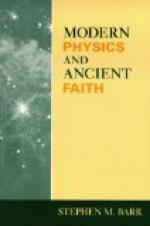Professor Lodge in 1884 put forth the theory that prakriti (physical matter) as we call it, was in its atoms but “whirls” of ether. Since then speculative science has generally accepted the idea that the physical atom is made up of many cubic feet of ether in chemical union, as many quarts of oxygen and hydrogen unite chemically to make a drop of water. This is an old story to the Hindu sage. He tells his pupils that the great globe of manasa once filled all space, and there was nothing else. Precisely as on this earth we have our elementary substances that change from liquids into solids and gases, so on this manasic globe there were elementary substances that took the form of liquids, solids and gases. Its manasic matter was differentiated and vibrated through one octave, as the prakritic matter does on the earth. Its substances combined as that does.
One combination produced prana. The prana collected, and formed globes. On these pranic globes the process was repeated, with ether as the result, and the etheric globes formed. Then the process was repeated on the etheric globes, as the modern scientists have discovered, and prakriti and prakritic globes came into being.
The true diameter of the earth, the ancient Hindu books say, is about 50,000 miles. That is to say, the true surface of the earth is the line of twenty-four-hour axial rotation; the line where gravity and apergy exactly balance; where a moon would have to be placed to revolve once in 86,400 seconds. Within that is prakriti; without is ether. It is also the line of no friction, which does exist between matter of different planes. There is friction between prakriti, between ether, between prana; but not between ether and prana, or ether and prakriti. Friction is a phenomenon confined to the matter of each plane separately. We live at the bottom of this gaseous ocean—on its floor —21,000 miles from the surface and only 4,000 miles from the center. Here, in a narrow “skin” limited to a few miles above and below us, is the realm of phenomena, where solid turns into liquid and liquid into gas, or vice versa. The lesson impressed upon the pupil’s mind by Hindu physics is that he lives far within the earth, not on it.
There is a comparatively narrow “skin” of and for phenomena within the etheric sun-globe, say the Eastern teachers, where the etheric solids, liquids, and gases meet and mingle and interchange. Within this “skin” are all the planets—the “gaseous” atmosphere of the etheric globe stretching millions of miles beyond the outermost planetary orbit. The earth is in this skin or belt of etheric phenomena, and its ether is in touch with the ether “in manifestation” on the etheric globe. The sun and other etheric globes are within the corresponding “skin” of phenomena of the pranic globes. The prana, manifesting as solid, liquid, and gas, or in combination and in forms, is in perfect touch with that of the etheric globe, and through that with the prana of the earth. That our prana is in touch with that on the pranic globe in all its manifestations means much in metaphysics. The same is true of the manasic globe, and of our manasa.




